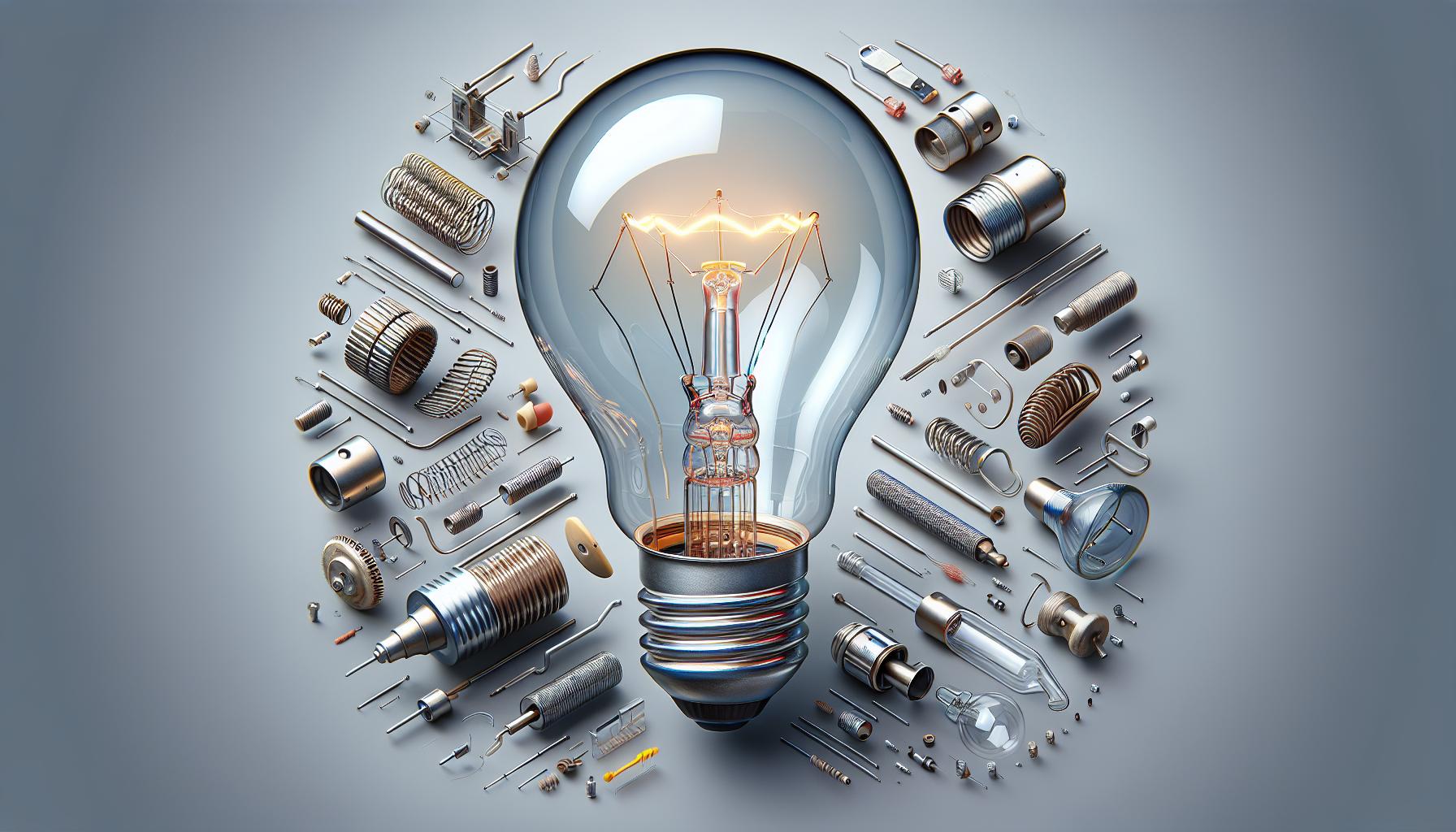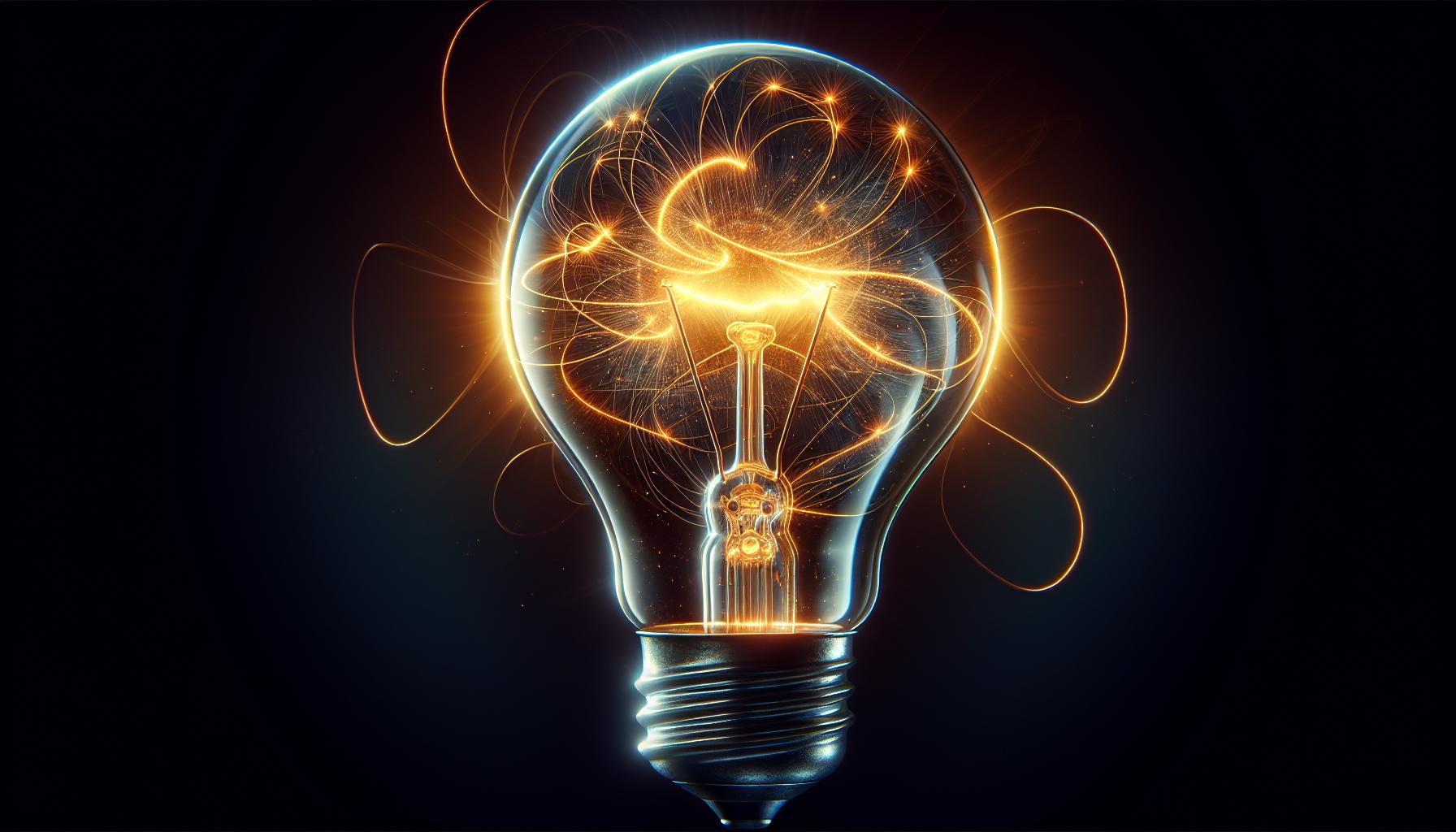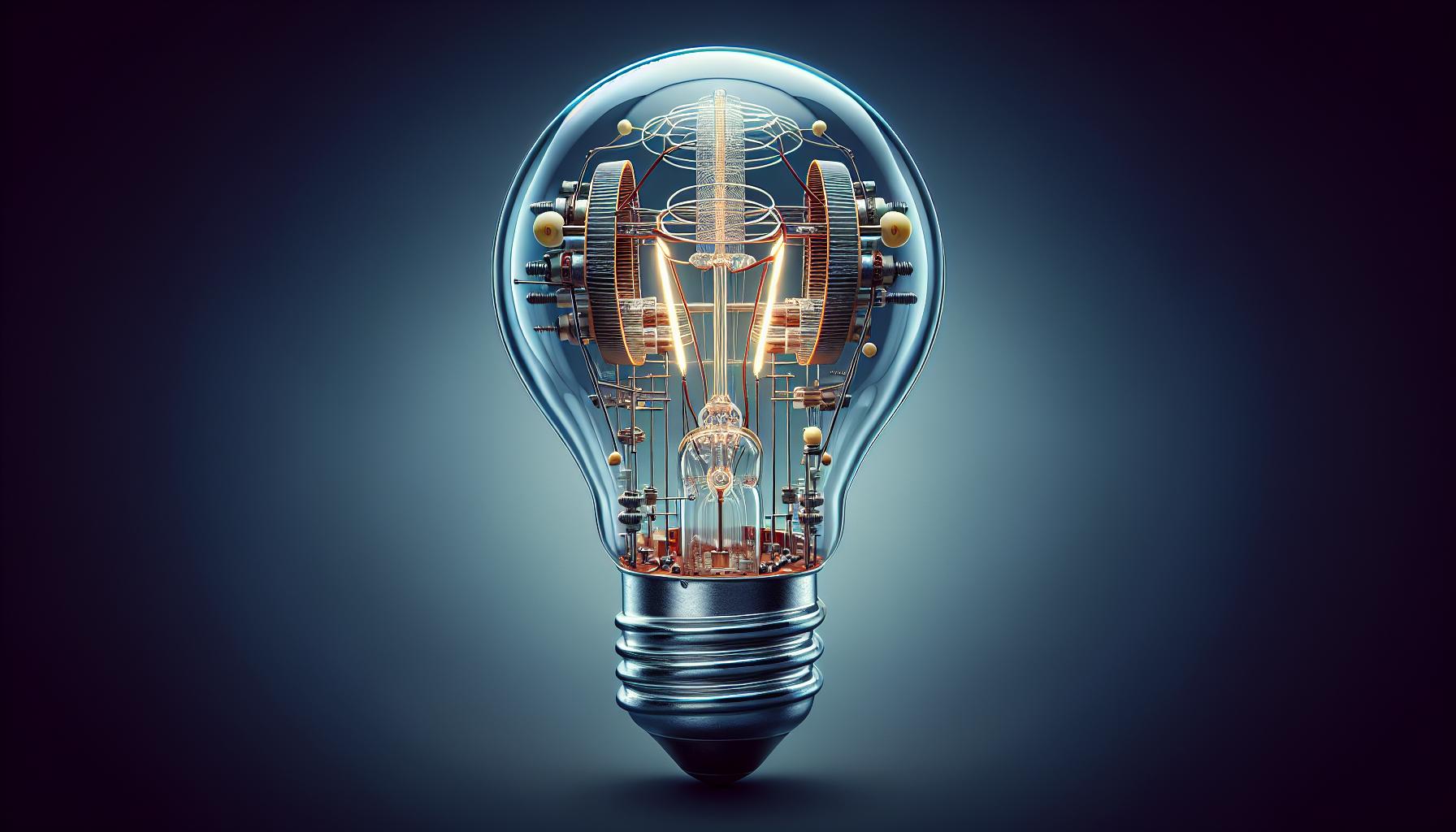Ever wondered how that little glass bulb lights up your room with just a flick of a switch? It’s a question that might’ve popped into your head during a late-night study session or while changing a burnt-out lamp. Well, you’re about to get enlightened!
Light bulbs are fascinating, aren’t they? They’re the unsung heroes of our everyday lives, turning dark into light and making sure you don’t stub your toe on the coffee table. Let’s dive into the bright world of light bulbs and discover the magic behind that warm glow.
How Does a Light Bulb Work?
In the world of home DIY and lighting, knowing the ins and outs of your trusty light bulb is like having a secret superpower. Delve into the workings of a light bulb, and you’ll discover it’s not just magic—it’s science at its brightest.
At the heart of a common incandescent light bulb is the filament—a thin wire usually made of tungsten. When you flick on the switch, electricity surges through this filament, heating it up to an intense temperature. It’s this heat that makes the filament glow bright, illuminating everything in its path.
But why doesn’t the filament just burn up? That’s where the clever design of the light bulb comes in. The filament is enclosed in a glass bulb that’s either vacuum-sealed or filled with an inert gas, like argon. This environment protects the filament from oxidizing—that is, from reacting with oxygen in the air and burning out.
It’s not just incandescent bulbs that light up your life, though. Compact fluorescent lamps (CFLs) and light-emitting diodes (LEDs) are the newer kids on the block, championing efficiency. CFLs work by driving an electric current through a tube containing argon and a small amount of mercury vapor. This generates invisible ultraviolet light that excites a fluorescent coating inside the tube to emit visible light.
LEDs, on the other hand, pass a current through a semiconductor, which converts electricity directly into light without the need for a filament or excess heat. This is why LEDs are known for being incredibly energy-efficient and long-lasting.
- Incandescents glow from heated filaments
- CFLs use mercury vapor and fluorescence
- LEDs convert electricity through semiconductors
Whether you’re screwing in a simple incandescent bulb or clicking a LED lamp into place, you’re wielding a tool refined by over a century of innovation. The next time you light up your space for a DIY project, think about the marvel of engineering that makes it all possible. With this understanding, every flip of the switch is a little more satisfying.
Components of a Light Bulb
When you switch on a light, you’re likely not pondering over the components that make up the bulb you’re illuminating. Let’s shine a light on the parts that come together to create this everyday marvel.
The glass envelope, or bulb itself, is your light bulb’s protective casing. It not only safeguards the delicate parts within but also contains either a vacuum or an inert gas like argon to prevent the filament from oxidation.
Inside this glass envelope is the filament. For incandescent bulbs, this is typically made from tungsten due to its high melting point. When an electrical current surges through, the filament heats up to a temperature where it begins to glow, lighting up your space.
Every light bulb also contains a base, usually made of metal and insulating material. The base secures the bulb to the lamp or socket, providing both mechanical support and the electrical connections needed to power the filament.
Let’s not overlook the support wires, which play the role of silent heroes, holding the filament in place and ensuring it remains centered so that the light disperses evenly.
« How to Make Light Bulbs Screw In Easier: Easy Tricks and Tools
What to Do If LED Light Bulb Breaks at Work: Your Ultimate Cleanup Guide »
Beyond these internals, the stem or mount is hidden from view, attached to the bulb’s base. It holds the wiring in place and creates a pathway for electrical current to reach the filament.
If you’re delving into the myriad types of bulbs like CFLs or LEDs, each has its unique components while sharing these general structures. CFLs have phosphor coatings on their tube interiors that absorb UV light and re-emit it as visible light, while LEDs have a semiconductor material that emits light when an electric current passes through it.
Understanding how these diverse elements come together not only feeds your curiosity but can make you a superstar in any home DIY lighting project. It’s about piecing together the right components for the perfect ambiance. And whether it’s setting up that vintage chandelier or optimizing the energy efficiency of your space, knowing your bulbs inside and out is a bright idea that’ll always pay off.
The Role of Electricity in Lighting Up the Bulb
Imagine this: you’re tackling a home DIY lighting project and you’ve got your bulb, your tools, and a goal to light up your space. At the heart of your project is electricity, that invisible force that brings your bulb to life. But how exactly does it work its magic?
Electricity plays a crucial role by flowing through the bulb’s components that you’re already familiar with—like the base, stem or mount, and those pivotal support wires. Think of electricity as a river of energy coursing through the bulb’s pathways: when you flip the switch, you’re releasing the floodgates.
In technical terms, when you apply an electrical voltage to the bulb, a current flows through the filament. The filament, usually tungsten because of its resilience to high temperatures, does something marvelous: it resists the flow. This resistance isn’t a drawback—it’s the source of brilliance. As the electrical current works against this resistance, the filament heats up, and voila, it glows, producing light.
The temperature of the filament climbs up to about 3,000 degrees Celsius in standard incandescent bulbs. That’s hot enough to cook! Here’s a quick look at what happens in terms of temperature rise:
| Filament Material | Temperature Range |
|---|---|
| Tungsten | 2,500 – 3,300 °C |
| Carbon | Typically below 2,500 °C |
| Various Alloys | Diverse depending on the mix |
It’s essential to understand that not all electrical currents are equal in the lighting world. Direct current (DC) gadgets require a steady flow, while alternating current (AC) appliances play nice with the back-and-forth current that’s typical in household wiring. And if you’ve ever wondered about those flickers and buzzes from some lights, it’s often a sign of battle—between the bulb and irregularities in the current.
What about those CFL and LED friends of ours? They operate on similar basic principles but with a twist. They use less energy and stay cool to the touch because they rely on different, more complex, components and reactions to produce light.
The Anatomy of a Light Bulb
Ever wonder what makes up the everyday light bulb? Let’s dissect its anatomy to satisfy your curiosity and enhance your DIY lighting projects.
The Base and Its Secrets
The story begins with the base of the bulb, typically made of metal or plastic, which serves two primary roles:
- It secures the bulb to the fixture.
- It provides the electrical contact necessary for power.
Inside the base, there’s a sophisticated arrangement of wires and contacts that ensure the smooth transition of electric current to the other components. The design may vary between bulb types, but the objective remains the same—reliable connectivity.
Moving Up to the Glass Envelope
As you move upwards, you’ll notice the glass enclosure, often called the envelope or bulb. This isn’t your average glass; it’s built to withstand high temperatures and contains either a vacuum or an inert gas like argon, preventing the filament from deteriorating quickly.
The Heart: The Filament
At the core of it all lies the filament, the part that truly brings the bulb to life—it’s the hero of our illumination story. When you flick the switch, this thin wire, typically made of tungsten for its high melting point, starts to dance with electrons, heating up until it glows and bathes your room in light.
Supporting Cast: Stem and Wires
Holding everything together is the stem, which anchors the filament in place. This support extends into the bulb and is attached to support wires that not only keep the filament centered but also conduct electricity from the base. This intricate support system ensures that your light shines bright and steady.
Understanding the parts that sing in harmony within the simple light bulb amplifies your appreciation and capability to handle lighting in your home. Each component, small or magnanimous, plays a pivotal role in those luminous moments you rely on day in and out.
Different Types of Light Bulbs
Now that you’ve got a grip on the anatomy of a light bulb, let’s shed some light on the various types you might come across in your DIY lighting projects. Each type has its perks and quirks—knowledge that’ll come in handy when you’re browsing the hardware store aisles or looking to set a specific mood in a room.
Incandescent Bulbs are the classic style that most people envision. They’re affordable and cast a warm, inviting light. Despite their widespread use, they’re not champions of efficiency, typically burning out faster than their modern counterparts.
Compact Fluorescent Lamps (CFLs) are the curly wonders of the lighting world. They consume less electricity than incandescent bulbs and have a longer lifespan. That means they’re gentler on your wallet over time and the environment. However, keep in mind that CFLs contain a small amount of mercury, so you’ll want to handle them with care and recycle properly.
Transitioning to Light Emitting Diodes (LEDs), you’re looking at the pinnacle of energy efficiency. LEDs trump both incandescent bulbs and CFLs in longevity and energy use. Plus, they come in a dazzling array of colors and dimming options. They may have a higher upfront cost, but they’ll pay for themselves with energy savings and infrequent replacements.
Halogen Bulbs are a type of incandescent that produce a bright, white light, perfect for task lighting. They’re more energy-efficient than traditional incandescent bulbs but still lag behind LEDs and CFLs in terms of energy conservation and lifespan.
Finally, there’s the High-Intensity Discharge (HID) Lights, typically used in outdoor areas and commercial spaces. These are powerhouse lights; they offer intense illumination and are incredibly efficient, best suited for stadiums, warehouses, and streetlights.
When selecting a bulb, consider not only the ambiance you want to create but also the energy consumption and longevity of the bulb. Each type has a unique set of characteristics that can suit your varied projects and spaces—remembering to keep efficiency and sustainability in mind can help illuminate the best choice for you.
Conclusion
You’ve journeyed through the fascinating world of light bulbs and now you’re equipped with the knowledge to choose the perfect glow for your space. Remember that whether it’s the warm hum of an incandescent bulb or the energy-efficient twinkle of an LED, each has its unique charm and purpose. You’re now ready to illuminate your home or project with confidence, keeping in mind the balance between ambiance, efficiency, and longevity. Happy lighting!
Frequently Asked Questions
What types of light bulbs are covered in this article?
This article discusses incandescent bulbs, compact fluorescent lamps (CFLs), light emitting diodes (LEDs), halogen bulbs, and high-intensity discharge (HID) lights, focusing on their uses in DIY lighting projects.
Which light bulb type is best for energy efficiency?
LED bulbs are the most energy efficient among the options mentioned, offering significant power savings and a longer lifespan compared to other types of light bulbs.
How do I choose the right light bulb for ambiance?
Consider the color temperature and dimming capabilities of the bulb. Incandescent and halogen bulbs often provide a warmer light, which is great for ambiance, while CFLs and LEDs offer a range of color temperatures suitable for different settings.
Are LED bulbs more expensive than other types?
Initially, LED bulbs tend to be more expensive than incandescent or halogen bulbs. However, they are more cost-effective in the long run due to their lower energy usage and extended lifespan.
What should I consider when selecting a light bulb for my project?
When selecting a light bulb, consider the desired ambiance, energy consumption, longevity of the bulb, and whether the light output fits the purpose of your project or space.





